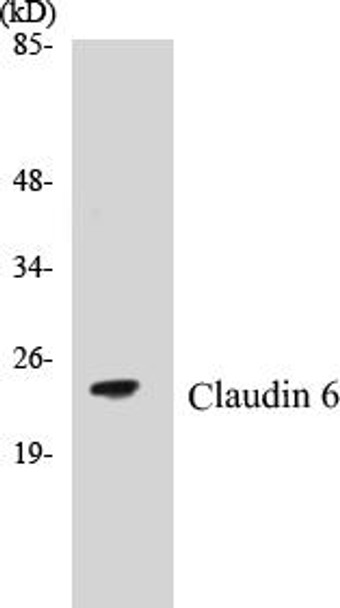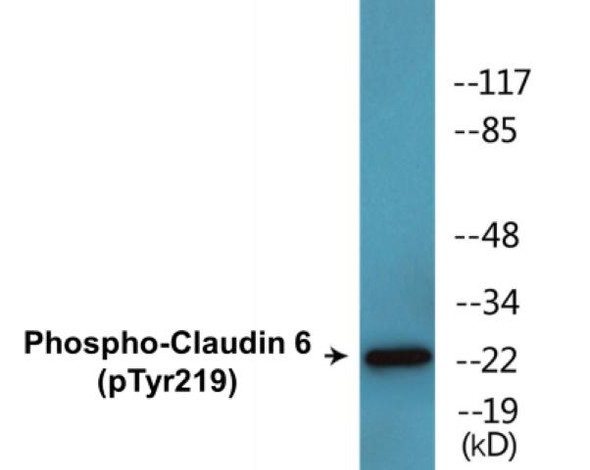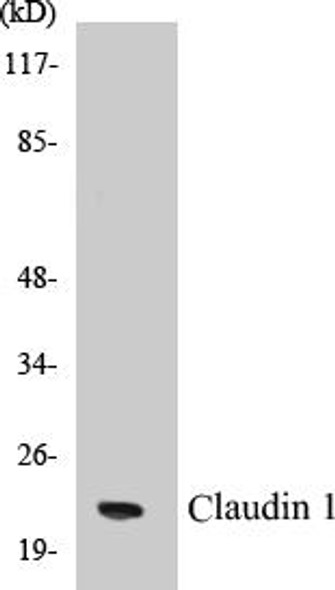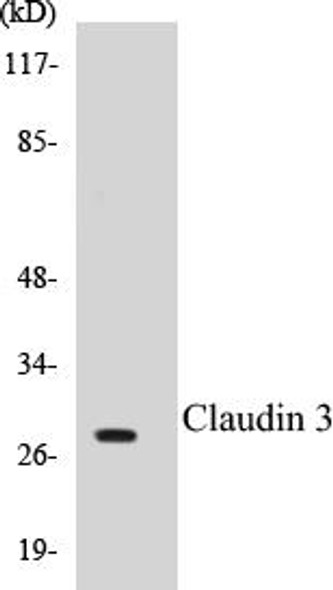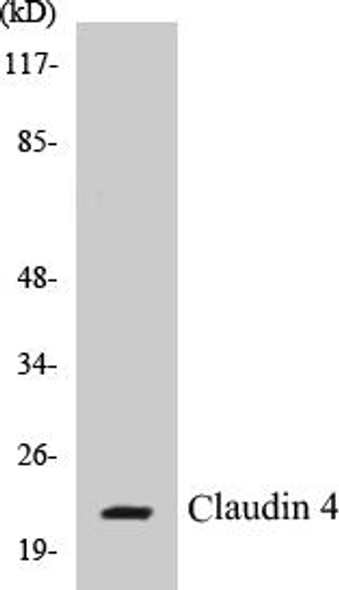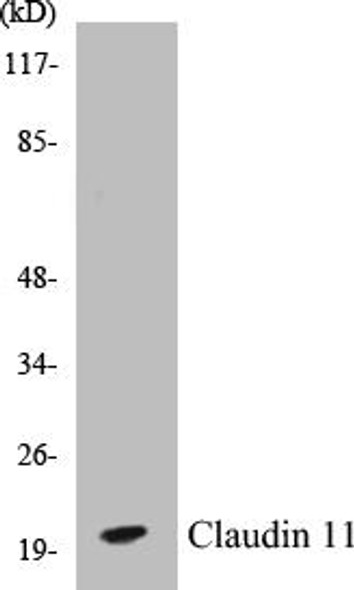Claudin 6 Colorimetric Cell-Based ELISA Kit
- SKU:
- CBCAB00588
- Product Type:
- ELISA Kit
- ELISA Type:
- Cell Based
- Research Area:
- Immunology
- Reactivity:
- Human
- Detection Method:
- Colorimetric
Description
Claudin 6 Colorimetric Cell-Based ELISA Kit
The Claudin-6 Colorimetric Cell-Based ELISA Kit from Assay Genie is a powerful tool for the accurate detection of Claudin-6 levels in cell samples. This kit offers high sensitivity and specificity, providing researchers with reliable and reproducible results for a variety of research applications.Claudin-6 is an integral membrane protein that plays a crucial role in tight junction formation, which is essential for maintaining cell barrier function and cell-cell communication. Dysregulation of Claudin-6 expression has been implicated in various diseases, including cancer and inflammatory disorders, making it a valuable biomarker for studying these conditions and developing potential therapies.
With the Claudin-6 Colorimetric Cell-Based ELISA Kit, researchers can easily quantify Claudin-6 levels in cell samples, allowing for a better understanding of its role in disease pathogenesis and potential therapeutic interventions. Trust Assay Genie for accurate and reliable results in your research endeavors.
| Product Name: | Claudin 6 Colorimetric Cell-Based ELISA |
| Product Code: | CBCAB00588 |
| ELISA Type: | Cell-Based |
| Target: | Claudin 6 |
| Reactivity: | Human |
| Dynamic Range: | > 5000 Cells |
| Detection Method: | Colorimetric 450 nmStorage/Stability:4°C/6 Months |
| Format: | 96-Well Microplate |
The Claudin 6 Colorimetric Cell-Based ELISA Kit is a convenient, lysate-free, high throughput and sensitive assay kit that can detect Claudin 6 protein expression profile in cells. The kit can be used for measuring the relative amounts of Claudin 6 in cultured cells as well as screening for the effects that various treatments, inhibitors (ie siRNA or chemicals), or activators have on Claudin 6.
Qualitative determination of Claudin 6 concentration is achieved by an indirect ELISA format. In essence, Claudin 6 is captured by Claudin 6-specific primary antibodies while the HRP-conjugated secondary antibodies bind the Fc region of the primary antibody. Through this binding, the HRP enzyme conjugated to the secondary antibody can catalyze a colorimetric reaction upon substrate addition. Due to the qualitative nature of the Cell-Based ELISA, multiple normalization methods are needed:
| 1. | A monoclonal antibody specific for human GAPDH is included to serve as an internal positive control in normalizing the target absorbance values. |
| 2. | Following the colorimetric measurement of HRP activity via substrate addition, the Crystal Violet whole-cell staining method may be used to determine cell density. After staining, the results can be analysed by normalizing the absorbance values to cell amounts, by which the plating difference can be adjusted. |
| Database Information: | Gene ID: 9074, UniProt ID: P56747, OMIM: None, Unigene: Hs.533779 |
| Gene Symbol: | CLDN6 |
| Sub Type: | None |
| UniProt Protein Function: | Claudin-6: Plays a major role in tight junction-specific obliteration of the intercellular space. Belongs to the claudin family. |
| UniProt Protein Details: | Protein type:Membrane protein, integral; Membrane protein, multi-pass; Cell adhesion Chromosomal Location of Human Ortholog: 16p13.3 Cellular Component: tight junction Molecular Function:identical protein binding Biological Process: calcium-independent cell-cell adhesion |
| NCBI Summary: | Tight junctions represent one mode of cell-to-cell adhesion in epithelial or endothelial cell sheets, forming continuous seals around cells and serving as a physical barrier to prevent solutes and water from passing freely through the paracellular space. These junctions are comprised of sets of continuous networking strands in the outwardly facing cytoplasmic leaflet, with complementary grooves in the inwardly facing extracytoplasmic leaflet. This gene encodes a component of tight junction strands, which is a member of the claudin family. The protein is an integral membrane protein and is one of the entry cofactors for hepatitis C virus. The gene methylation may be involved in esophageal tumorigenesis. This gene is adjacent to another family member CLDN9 on chromosome 16.[provided by RefSeq, Aug 2010] |
| UniProt Code: | P56747 |
| NCBI GenInfo Identifier: | 90183180 |
| NCBI Gene ID: | 9074 |
| NCBI Accession: | P56747.2 |
| UniProt Secondary Accession: | P56747,B3KQP9, D3DUA5, |
| UniProt Related Accession: | P56747 |
| Molecular Weight: | 23,292 Da |
| NCBI Full Name: | Claudin-6 |
| NCBI Synonym Full Names: | claudin 6 |
| NCBI Official Symbol: | CLDN6 |
| NCBI Protein Information: | claudin-6 |
| UniProt Protein Name: | Claudin-6 |
| UniProt Synonym Protein Names: | Skullin |
| Protein Family: | Claudin |
| UniProt Gene Name: | CLDN6 |
| UniProt Entry Name: | CLD6_HUMAN |
| Component | Quantity |
| 96-Well Cell Culture Clear-Bottom Microplate | 2 plates |
| 10X TBS | 24 mL |
| Quenching Buffer | 24 mL |
| Blocking Buffer | 50 mL |
| 15X Wash Buffer | 50 mL |
| Primary Antibody Diluent | 12 mL |
| 100x Anti-Phospho Target Antibody | 60 µL |
| 100x Anti-Target Antibody | 60 µL |
| Anti-GAPDH Antibody | 60 µL |
| HRP-Conjugated Anti-Rabbit IgG Antibody | 12 mL |
| HRP-Conjugated Anti-Mouse IgG Antibody | 12 mL |
| SDS Solution | 12 mL |
| Stop Solution | 24 mL |
| Ready-to-Use Substrate | 12 mL |
| Crystal Violet Solution | 12 mL |
| Adhesive Plate Seals | 2 seals |
The following materials and/or equipment are NOT provided in this kit but are necessary to successfully conduct the experiment:
- Microplate reader able to measure absorbance at 450 nm and/or 595 nm for Crystal Violet Cell Staining (Optional)
- Micropipettes with capability of measuring volumes ranging from 1 µL to 1 ml
- 37% formaldehyde (Sigma Cat# F-8775) or formaldehyde from other sources
- Squirt bottle, manifold dispenser, multichannel pipette reservoir or automated microplate washer
- Graph paper or computer software capable of generating or displaying logarithmic functions
- Absorbent papers or vacuum aspirator
- Test tubes or microfuge tubes capable of storing ≥1 ml
- Poly-L-Lysine (Sigma Cat# P4832 for suspension cells)
- Orbital shaker (optional)
- Deionized or sterile water
*Note: Protocols are specific to each batch/lot. For the correct instructions please follow the protocol included in your kit.
| Step | Procedure |
| 1. | Seed 200 µL of 20,000 adherent cells in culture medium in each well of a 96-well plate. The plates included in the kit are sterile and treated for cell culture. For suspension cells and loosely attached cells, coat the plates with 100 µL of 10 µg/ml Poly-L-Lysine (not included) to each well of a 96-well plate for 30 minutes at 37°C prior to adding cells. |
| 2. | Incubate the cells for overnight at 37°C, 5% CO2. |
| 3. | Treat the cells as desired. |
| 4. | Remove the cell culture medium and rinse with 200 µL of 1x TBS, twice. |
| 5. | Fix the cells by incubating with 100 µL of Fixing Solution for 20 minutes at room temperature. The 4% formaldehyde is used for adherent cells and 8% formaldehyde is used for suspension cells and loosely attached cells. |
| 6. | Remove the Fixing Solution and wash the plate 3 times with 200 µL 1x Wash Buffer for five minutes each time with gentle shaking on the orbital shaker. The plate can be stored at 4°C for a week. |
| 7. | Add 100 µL of Quenching Buffer and incubate for 20 minutes at room temperature. |
| 8. | Wash the plate 3 times with 1x Wash Buffer for 5 minutes each time. |
| 9. | Add 200 µL of Blocking Buffer and incubate for 1 hour at room temperature. |
| 10. | Wash 3 times with 200 µL of 1x Wash Buffer for 5 minutes each time. |
| 11. | Add 50 µL of 1x primary antibodies (Anti-Claudin 6 Antibody and/or Anti-GAPDH Antibody) to the corresponding wells, cover with Parafilm and incubate for 16 hours (overnight) at 4°C. If the target expression is known to be high, incubate for 2 hours at room temperature. |
| 12. | Wash 3 times with 200 µL of 1x Wash Buffer for 5 minutes each time. |
| 13. | Add 50 µL of 1x secondary antibodies (HRP-Conjugated AntiRabbit IgG Antibody or HRP-Conjugated Anti-Mouse IgG Antibody) to corresponding wells and incubate for 1.5 hours at room temperature. |
| 14. | Wash 3 times with 200 µL of 1x Wash Buffer for 5 minutes each time. |
| 15. | Add 50 µL of Ready-to-Use Substrate to each well and incubate for 30 minutes at room temperature in the dark. |
| 16. | Add 50 µL of Stop Solution to each well and read OD at 450 nm immediately using the microplate reader. |
(Additional Crystal Violet staining may be performed if desired – details of this may be found in the kit technical manual.)

